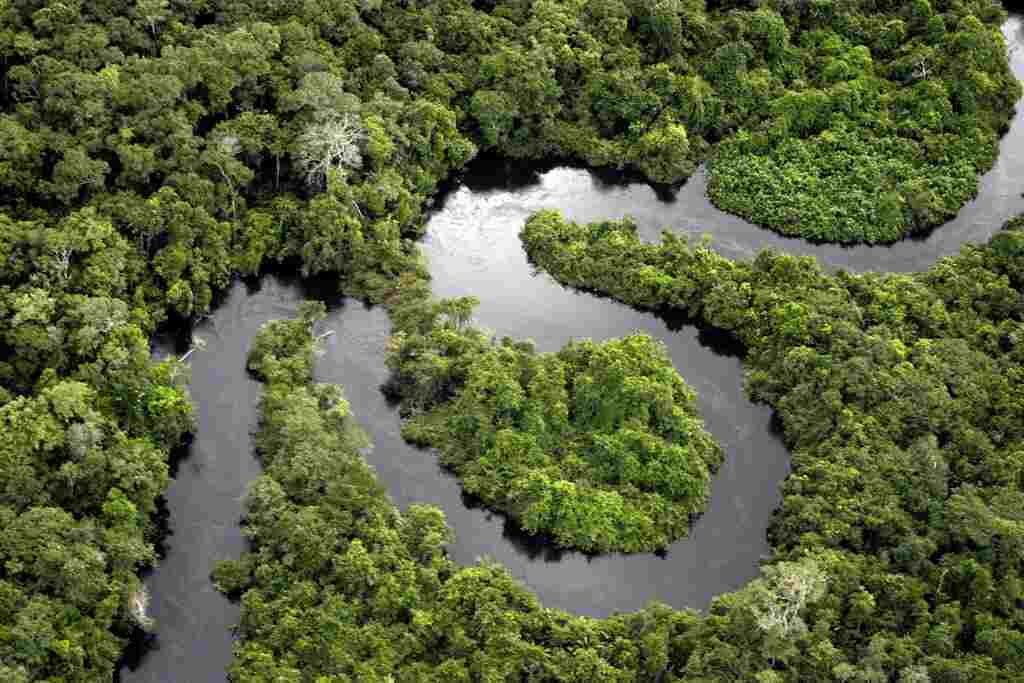The Amazon Rainforest: A Journey through Brazil’s Biodiverse Treasure
The Amazon Rainforest is one of the most biodiverse regions on Earth, home to countless species of plants, animals, and insects. The Amazon is the largest territory in Brazil and has a unique geography. This article will explore the unique flora and fauna of the Amazon, as well as the popular eco-tourism activities and conservation efforts in the region.
Amazon is the world’s largest rainforest. It croses eight South American countries: Brazil, Bolivia, Peru, Ecuador, Colombia, Venezuela, Guyana, and Suriname, as well as French Guiana, a department of France.
In this article we delve into the incredible biodiversity of the Amazon rainforest in Brazil, highlighting the unique flora and fauna that call this region home. It includes information about popular eco-tourism activities in the Amazon, such as guided hikes, wildlife spotting, and visits to indigenous communities. It touches on the importance of conservation efforts in the region, and highlight ways in which travelers can support sustainable tourism initiatives in the Amazon.
Biodiversity of the Amazon
The Amazon Rainforest is home to over 40,000 plant species, 1,300 bird species, and thousands of other animals, including jaguars, anacondas, and monkeys. This section of the article will delve into the incredible variety of life in the Amazon and highlight some of the most interesting and rare species.

Jaguar in the Amazon. ArticleAmazon, CC BY-SA 4.0, via Wikimedia Commons
Here are some important points to consider when exploring the Amazon’s rich ecosystem:
- The Amazon is the largest rainforest in the world, covering over 2.7 million square miles across South America.
- It is home to more than 40,000 plant species and over 1,300 bird species, as well as a diverse range of mammals, reptiles, and insects.
- Some of the most unique species found in the Amazon include the jaguar, the giant otter, the pink river dolphin, and the harpy eagle.
- The Amazon also boasts the largest freshwater ecosystem in the world, with over 3,000 species of fish living in its rivers and tributaries.

Poison dart frogs (dendrobatidae) are well known for their brightly colored skin. The bright colors warn potential predators of their toxicity. They can be found in humid, tropical environments of Central and South America. Termininja, CC BY-SA 4.0, via Wikimedia Commons
Examples:
- The Victoria Amazonica water lily is a stunning plant species found in the Amazon that can grow up to three meters in diameter.
- The Amazon’s black caiman is a large reptile species that can grow up to six meters long and is a top predator in the region.
Eco-tourism Activities
One of the best ways to experience the Amazon Rainforest is through eco-tourism activities such as guided hikes, wildlife spotting, and visits to indigenous communities. This section will provide information on the most popular eco-tourism activities in the region, including how to book and what to expect.
Eco-tourism activities offer a unique opportunity to explore the Amazon rainforest while supporting sustainable tourism initiatives.
Here are some popular eco-tourism activities to consider when planning a trip to the Amazon:
- Guided hikes and nature walks are a great way to explore the Amazon’s diverse flora and fauna, and learn about the unique ecology of the region.
- Wildlife spotting tours allow visitors to see some of the Amazon’s most iconic species, including jaguars, giant otters, and macaws.
- Cultural tours offer the chance to visit indigenous communities and learn about their traditions, history, and way of life.
Examples:
- Canoeing or kayaking down the Amazon River is a popular activity that allows visitors to see the rainforest from a different perspective and potentially spot wildlife along the riverbanks.
- Visiting the Mamirauá Sustainable Development Reserve, a protected area in the Amazon, offers opportunities to learn about conservation efforts and sustainable development in the region.

Amazon rainforest jungle resort. James Martins, CC BY 3.0, via Wikimedia Commons
Conservation Efforts
The Amazon Rainforest is under threat from deforestation, mining, and other forms of human activity. This section of the article will explore the importance of conservation efforts in the region, highlighting some of the initiatives that are working to protect the rainforest and its inhabitants.
Here are some important conservation efforts that are working to protect the Amazon and its unique ecosystem:
- Protected areas, such as national parks and reserves, are essential for conserving the Amazon’s biodiversity and ecosystem services.
- Conservation initiatives that work with indigenous communities are important for protecting traditional knowledge and ensuring sustainable resource management.
- Sustainable agriculture and forestry practices can help reduce the impact of deforestation and other forms of land use change in the Amazon.
Examples:
- The Amazon Conservation Association works to protect the Amazon’s biodiversity and promote sustainable development in the region through conservation science, education, and community engagement.
- The Amazon Sustainable Landscapes Program is a collaborative effort between the Brazilian government and private sector partners to promote sustainable land use practices in the Amazon.
Supporting Sustainable Tourism
Brazil, aware of its natural assets, has developed in recent years a new form of green tourism. With the awareness of the ecological importance of the Amazon at the global level, the country has implemented many conservation systems. The ecolodges are a perfect example of how Brazil wishes to develop the tourist economy in this region, in perfect osmosis with its natural heritage.
Travelers can help support sustainable tourism initiatives in the Amazon by choosing eco-friendly accommodations, supporting local businesses, and avoiding activities that may harm the environment or local communities. This section will offer tips on how travelers can be responsible and ethical tourists in the Amazon.
As a responsible traveler, it’s important to support sustainable tourism initiatives in the Amazon and minimize your impact on the region.
Here are some ways you can support sustainable tourism when visiting the Amazon:
- Choose eco-friendly accommodations that use renewable energy, minimize water and energy consumption, and support local communities.
- Support local businesses and artisans by buying locally-made products and souvenirs, and eating at locally-owned restaurants.
- Respect the environment by following leave-no-trace principles, avoiding single-use
Idea:
This article aims to showcase the incredible biodiversity of the Amazon Rainforest, while also providing practical information on how to experience the region through sustainable and responsible eco-tourism. It is intended for travelers who are interested in exploring one of the world’s most unique and important ecosystems, while also supporting efforts to protect it.
Read also: 2 Weeks itinerary to Brazil: Arrive From Sao Paulo Departure From Rio de Janeiro
AMAZONIAN STATES
Whether in Pará, Amapa, Roraima, Acre or Amazonas, the climate is hot and very humid, a direct consequence of the immense ecosystem of the ubiquitous forest. The forest has the highest specific biodiversity in the world, and is home to more species than the rainforests of Africa and Asia. Being the largest region of tropical rainforest in America, one in ten animal or plant species in the world lives in the Amazon rainforest, which constitutes the largest collection of animals or plants.
Amazonas
Amazonas is the largest of the Brazilian states in area with 1,664,000 km². It is mainly wooded by the Amazon rainforest. Composed of nearly 390 billion trees and 16,000 different species, this forest is the largest reservoir of biodiversity in the world. There are nearly 60 times more “adult” trees in the Amazon rainforest than humans on the planet as a whole. This natural wealth is unfortunately threatened by deforestation due to some aspects of poorly controlled economic activity. In order to preserve this ecosystem, Brazil has invested in the Central Amazon Conservation Complex.

Amazon River, near to Fonte Boa (Amazonas). Flooded areas, minor channel and lagoons are observed near at the main channel of the river. NASA, Public domain, via Wikimedia Commons
Manaus
The capital of Amazonas, Manaus, is the largest city in the Amazon, huge and modern (more than two million inhabitants in its large agglomeration). However, its rich past is still present in many of its monuments and offers many opportunities for visits. The city experienced its golden age in the 19th century with the exploitation of rubber trees, the extraction of which benefited the entire global automotive industry. It is now a special zone where industrial taxes have been reduced to stimulate the local economy. Thanks to this measure, it regained a good momentum and today plays a decisive role in the national economy. 3rd pole of Brazilian industry before the 2 big rivals Carioca and Paulista in the South of the country.

Beach black river near Manaus, Brazil. James Martins, CC BY 3.0, via Wikimedia Commons
Para
With an area of 1,247,689 km2, Pará is the second largest state in the country. Its area is larger than that of France and England combined. Pará is bordered by Suriname, Guyana and the state of Amapá to the north, the Atlantic Ocean to the northeast, the state of Maranhão to the east, Tocantins to the southeast, Mato Grosso to the south, Amazonas to the west and Roraima to the northwest.
Also mainly occupied by a dense jungle, it nevertheless opens onto the Atlantic Ocean via the immense estuary of the Amazon River. The state economy is mainly based on the exploitation of natural resources, particularly mineral (iron, bauxite, manganese, limestone, gold, tin) and plant (wood). The other main sectors are agriculture, livestock, industry and tourism.

Boat houses on Cumbu Island, Brazil, State of Parà. Cayambe, CC BY-SA 3.0, via Wikimedia Commons
Belem
Founded in 1616 by the Portuguese colony, Belém is the capital of the state of Pará. It is the largest city in the northern region of Brazil (1,323,000 inhabitants). There is a large industrious port landlocked at the confluence of the Rios Acara and Guama in the complex estuary of the Amazon which opens to the Atlantic, a few hundred kilometers away. It is above all a city totally immersed in the richness of Portuguese architecture of the 16th and 17th centuries, guardian of North Brazilian culture and gastronomy.
Marajo Island
It is the largest island in the world surrounded by fresh water, about the size of Switzerland! It is also an ecosystem of exceptional richness and diversity. Very flat, barely 10 meters above sea level, it offers a semi-submerged equatorial forest to the west. It is almost impenetrable except by canoe accompanied by a guide. Its fauna is lush, especially during the rainy season (January to September) when whole companies of migratory birds from North America come to find refuge in this haven of peace.
On the other part of the island of Marajo, there is a vast territory of swamps and meadows. The island, populated by peasants and a few traders in its largest city, Souré, lives mainly from fishing, agriculture and of course tourism.
Acre
Wedged in the southeast between Bolivia and the Amazon, the state of Acre is the extension of the Amazonian forest which comes up against the foothills of the Andes. It is also the last part of Brazilian territory to have been incorporated into the country, in 1904. It was also the scene of a war between the two countries which disputed the wealth resulting from the extraction of gold and local rubber.
Roraima and Amapa
To the north of the Amazon are two states with strong particularism. Roraima in the far north is Brazil’s northernmost state, one of the few most of which lies above the Equator. Much of the land is also inaccessible and 70% of the state is occupied by the Amazon rainforest. The economy is based on agriculture and crops, livestock and extraction of wood, gold and diamonds.
Located further east above Pará, the state of Amapa is distinguished by a linguistic particularism: in 1999, the teaching of French was made compulsory in public schools, following of a federal law obliging the country’s schools to teach at least one foreign language. Its immediate proximity to French Guiana to the north has something to do with it. This administrative measure has made Amapa the only Brazilian state with a French-speaking tendency, even if French is little spoken there today compared to Brazilian.
Sources: PinterPandai, World Wildlife Fund (WWF), Time Magazine
Photo credit: Jlwad (CC BY-SA 4.0) via Wikimedia Commons
Photo description: river in the Amazon Rainforest.



